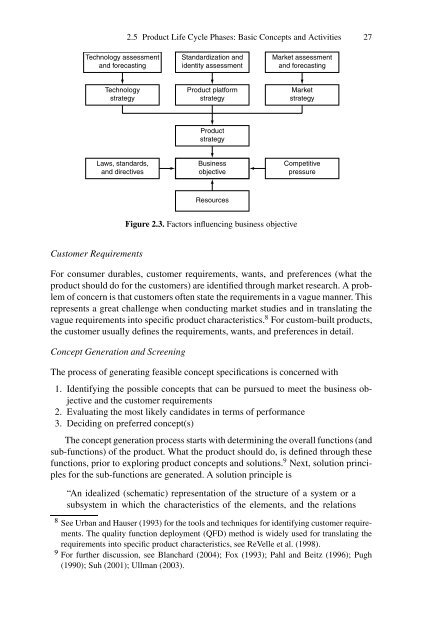9781848002708-c1
Create successful ePaper yourself
Turn your PDF publications into a flip-book with our unique Google optimized e-Paper software.
2.5 Product Life Cycle Phases: Basic Concepts and Activities 27<br />
Technology assessment<br />
and forecasting<br />
Standardization and<br />
identity assessment<br />
Market assessment<br />
and forecasting<br />
Technology<br />
strategy<br />
Product platform<br />
strategy<br />
Market<br />
strategy<br />
Product<br />
strategy<br />
Laws, standards,<br />
and directives<br />
Business<br />
objective<br />
Competitive<br />
pressure<br />
Resources<br />
Figure 2.3. Factors influencing business objective<br />
Customer Requirements<br />
For consumer durables, customer requirements, wants, and preferences (what the<br />
product should do for the customers) are identified through market research. A problem<br />
of concern is that customers often state the requirements in a vague manner. This<br />
represents a great challenge when conducting market studies and in translating the<br />
vague requirements into specific product characteristics. 8 For custom-built products,<br />
the customer usually defines the requirements, wants, and preferences in detail.<br />
Concept Generation and Screening<br />
The process of generating feasible concept specifications is concerned with<br />
1. Identifying the possible concepts that can be pursued to meet the business objective<br />
and the customer requirements<br />
2. Evaluating the most likely candidates in terms of performance<br />
3. Deciding on preferred concept(s)<br />
The concept generation process starts with determining the overall functions (and<br />
sub-functions) of the product. What the product should do, is defined through these<br />
functions, prior to exploring product concepts and solutions. 9 Next, solution principles<br />
for the sub-functions are generated. A solution principle is<br />
“An idealized (schematic) representation of the structure of a system or a<br />
subsystem in which the characteristics of the elements, and the relations<br />
8 See Urban and Hauser (1993) for the tools and techniques for identifying customer requirements.<br />
The quality function deployment (QFD) method is widely used for translating the<br />
requirements into specific product characteristics, see ReVelle et al. (1998).<br />
9 For further discussion, see Blanchard (2004); Fox (1993); Pahl and Beitz (1996); Pugh<br />
(1990); Suh (2001); Ullman (2003).



